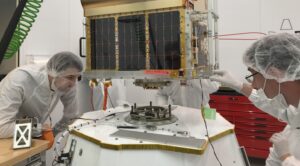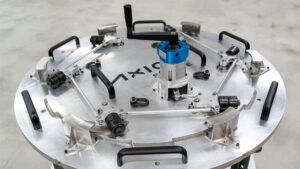
How Rocket Lab Is Reusing Small Lift Launch Vehicles
Close to 3 years ago in late 2020, during the Return To Sender mission, Rocket Lab attempted their first go at rocket reusabilty. At that point, the plan was in its earliest stages and they managed to safely parachute the booster into the ocean for recovery. Up until that point the company had just been discarded the boosters after stage separation.
Since then, Rocket Lab has tried a few different methods with the main goal of refurbishing and reusing the entire first stage. Only days ago however they managed to complete the most significant development yet when they successfully launched Electron with a reused Rutherford engine. This is a big deal for the company and supports its claims that within a few months from now, an entirely reused Electron booster will launch a dedicated mission.
If all goes according to plan, Rocket Lab could end up saving a lot of money and launching much more frequently. When it comes to small lift launch vehicles like Electron, reusability is somewhat unheard of due to its smaller size, lower fuel margins, savings, etc. Here I will go more in-depth into the recent milestone, when we can expect a reused booster to launch, how this could change Rocket Lab’s business, and more.
First Engine Reuse

Up until yesterday, all of Rocket Lab’s reusability-related work had to do with getting first-stage rocket components back from space in good condition. In other words, they had been working on first-stage heat shield technology, drogue and parachute deployment, and especially waterproofing. In 2022, during the “There and Back Again” mission, Rocket Lab caught the first stage out of mid-air with a helicopter before it was slowly dropped into the ocean after the pilot detected unusual load characteristics. The stage was then recovered by boat and brought back to Rocket Lab’s factory.
At this point, they took apart the first stage and tried to determine what could be reused if anything. Around four months after the stage had splashed down in the ocean, the company managed to successfully test fire a reused Rutherford first stage engine that they had refurbished. This leads us to yesterday when Rocket Lab launched the “We Love The Nightlife” Mission. The launch took place from Complex 1 on New Zealand’s Mahia Peninsula for American space tech company Capella Space (Capella), a leading provider of commercial Synthetic Aperture Radar (SAR) imagery.
Of the 9 Rutherford engines powering the first stage, for the first time, one of these engines had already flown. It was the engine that passed down over a year ago and completed the successful hot fire. Soon after the launch, Rocket Lab CEO Peter Beck tweeted saying, “The data is in, perfect performance from the reused engine and the stage.” Images of the booster before the launch highlight 8 brand new engines and one engine still partially black from past testing and firings.
While the reuse of just a single engine may not seem significant, this was one of the final steps that needed to be tested before flying an entirely reused booster. Specifically, during an earnings call earlier this month, Beck suggested that reflying a Rutherford engine was one of the final steps before the company is ready to reuse an entire booster. “From there we’ll schedule the first reflight of a full stage booster,” he said in the call, but did not offer a timeline for doing so beyond noting that additional improvements to support reusability were planned for the 45th flight of the vehicle.
This suggests that before the end of the year, we could see an already-launched Electron booster take off a second time. It is also important to point out that yesterday’s mission was a recovery one. Electron’s first stage was brought back to Earth under a parachute for a splashdown in the Pacific Ocean for retrieval. Since deciding to focus solely on marine recovery operations, the Recovery team has made notable alterations to Electron that will progressively iterate marine salvage solutions. Recovery Electrons are now specifically designed to spend time in the ocean. This means improved sealing solutions for the interstage, powerpack, and some internal components on the Rutherford engines to improve saltwater resilience. The expectation for these modifications and upgrades is that the engines will be fully resilient.
It’s possible that the first Electron booster to take off again is the one that just splashed down in the ocean. Before the most recent launch, Rocket Lab decided to replace the entire booster with one that the company had just completed. This new replacement booster, unlike the original one, was designed for recovery. “The call was made to bring forward that recovery booster and swap the payload onto this Electron to tighten the turnaround to get back to the pad for Capella and accelerate our efforts to make Electron a reusable rocket at the exact same time,” said a Rocket Lab spokesperson.
Electron Reusability

Despite working on Electron reusability for years now, it seems like in the last few months the company has been working extra hard on this process. On the mission just before the most recent launch, a big focus was more booster reuse upgrades and even boat recovery work.
On that launch, the company was putting a lot of focus on getting to Electron’s booster as fast as possible, and removing it from the water quickly as well. “There are some internal vehicle changes to improve its ability to keep water out of the areas where we don’t want it,” said Peter Beck, in an interview. “We’ve taken this next opportunity to improve the watertightness of the vehicle.” He also commented that the new method of getting Electron out of the water “makes it much simpler to recover and much less likely to damage the stage during recovery.”
Beck said the company is taking a “methodical” approach to reusability, making incremental steps that get it closer to full reuse. “I’m sure we’ll learn something from this mission and we’ll probably make some tweaks again to the next one. We’re methodically walking step-by-step and taking the opportunity to get it right” he said.
If Rocket Lab were to successfully launch a reused Electron booster in the next few months, it would change how the company operates. While the money saved from reuse is great, the biggest benefit for most companies is the increase in launch cadence. SpaceX has been a great example as they continue to break launch records with Falcon 9. This is facilitated by the much quicker process of refurbishing a used booster rather than completely building a new one. Rocket Lab now has three launch pads across two different launch sites. This means launch operations are open and they could utilize this space.
The other important part of Electron reuse is the experience gained that can be applied to Neutron. In reality, the future of Rocket Lab is the Neutron program. The Neutron launch vehicle is designed to transform space access by delivering reliable and cost-effective launch services for satellite mega-constellations, deep space missions and human spaceflight.
Reusability is key to enabling frequent and affordable launch, so the ability to launch, land and lift-off again has been built into every aspect of Neutron’s design from day one. After reaching space and deploying Neutron’s second stage, the first stage will return to Earth for a propulsive landing at the launch site, eliminating the high costs associated with ocean-based landing platforms and operations.
In relation to recent Rutherford developments, Neutron will be powered by an entirely new rocket engine, Archimedes. Nine Archimedes engines will propel Neutron’s first stage, with a single vacuum optimized Archimedes engine on the second stage. Neutron’s lightweight carbon composite structure means Archimedes does not need the immense performance and complexity typically associated with larger rockets and their propulsion systems. By developing a simple engine with modest performance requirements, the timeline for development and testing can be drastically accelerated. They also are designing the engine to be reused again and again.
In terms of progress, right now Rocket Lab is working on the production complex and actual Neutron test hardware. The Neutron Production Complex will be home to a rocket production, assembly, and integration facility, as well as a dedicated launch pad for the Neutron rocket located on the southern end of Wallops Island. The estimated 250,000 square foot state-of-the-art complex will be constructed on a 28-acre site adjacent to the Wallops Island Flight Facility and will include a Launch Control Center, Rocket Lab’s fifth global operations center for launch activities and on-orbit operations.
“Neutron is not a conventional rocket. Neutron incorporates the best innovations of the past and marries them with cutting edge technology and materials to deliver a rocket for the future,” said Peter Beck. “More than 80% of the satellites to be launched in the next decade are expected to be constellations, which have unique deployment needs that Neutron is the first vehicle to address specifically. Like we did with Electron, rather than starting with a traditional rocket design, we focused on our customers’ needs and worked back from there. The result is a rocket that is right-sized for market demand and can launch fast, frequently and affordably” he said.
As for the engine that was just reused, before launch, the engine passed all of the same rigorous acceptance tests Rocket Lab performs for every engine, including 200 seconds of engine fire and multiple restarts. Data from the test fire shows the engine produced full thrust of 21kNs within 1000 milliseconds of ignition and performed to the same standard of a newly-built Rutherford engine. After this original engine fire Peter Beck said, “We’ve always been at the forefront of innovation with Electron, having pushed the boundaries of many technologies including carbon composites, electric turbo-pumps and 3D printed rocket engines. Now, we’re leading the pack once again bringing reusability to small launch vehicles.”
Conclusion
Rocket Lab just completed the final step before a full Electron booster is reused. The most recent mission featured a single Rutherford engine that had previously flown and splashed down in the Ocean. We will have to wait and see how it progresses and the impact it has on the space industry.



